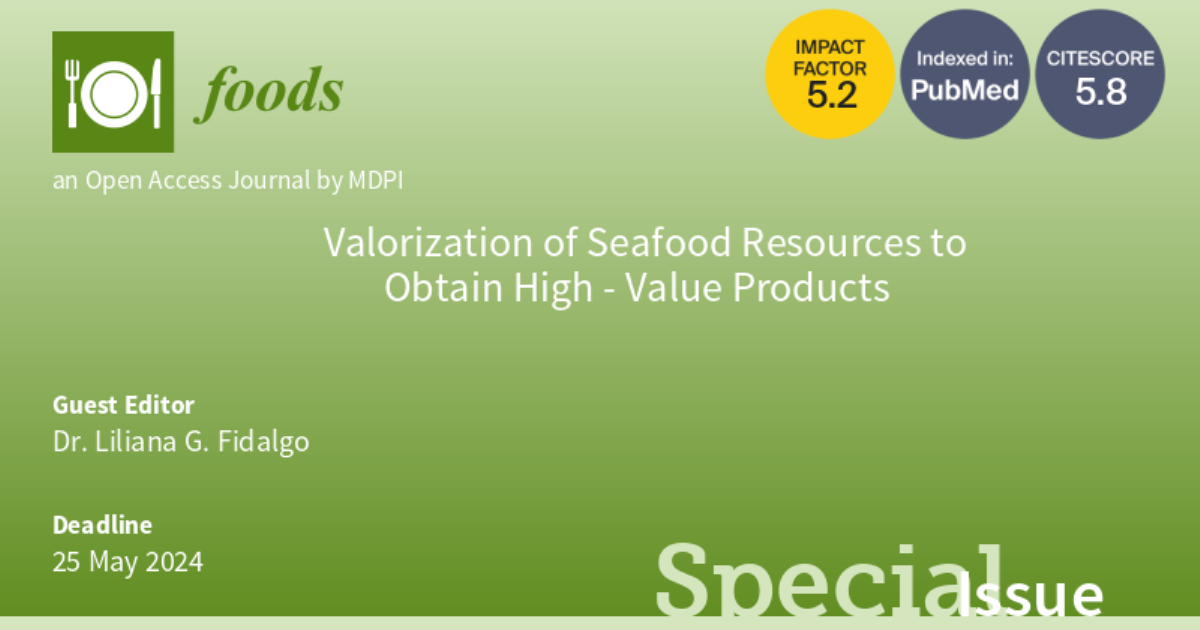Valorization of Seafood Resources to Obtain High-Value Products
A special issue of Foods (ISSN 2304-8158). This special issue belongs to the section "Foods of Marine Origin".
Deadline for manuscript submissions: 25 May 2024 | Viewed by 4752

Special Issue Editor
Interests: food science and technology; food processing; biotechnology; biochemistry; microbiology; high pressure technology; food analysis; food chemistry; food quality; meat science; fish science
Special Issue Information
Dear Colleagues,
Seafood products are an important part of diets in many nations, playing a significant role with functional and bioactive components that are essential to human health, such as proteins, lipids, minerals, vitamins, and high amounts of long-chain omega-3 polyunsaturated fatty acids. The retention of nutritional properties and the product quality of seafood is dependent on the proper handling of the catch after it has been harvested, as well as final processing, such as heating and freezing.
Furthermore, in industry or local seafood shops, processing of seafood generates a huge quantity of nonedible by-products, which are discarded as waste or underutilised in several parts of the world. These by-products are rich sources of various valuable biomolecules. Their sustainable valorisation may lead toward the development of healthy and functional food ingredients/products.
This Special Issue invites original research, short communications, and review papers related to seafood and processing waste as sources of bioactive ingredients for the creation of value-added products. Additionally, we encourage papers focusing on innovative and sustainable preservation technologies, or extraction methodologies, to develop new value-added products from seafood resources. Studies may cover the characterization of nutritional and bioactive compounds or the quality of seafood resources.
We look forward to receiving your contributions.
Dr. Liliana G. Fidalgo
Guest Editor
Manuscript Submission Information
Manuscripts should be submitted online at www.mdpi.com by registering and logging in to this website. Once you are registered, click here to go to the submission form. Manuscripts can be submitted until the deadline. All submissions that pass pre-check are peer-reviewed. Accepted papers will be published continuously in the journal (as soon as accepted) and will be listed together on the special issue website. Research articles, review articles as well as short communications are invited. For planned papers, a title and short abstract (about 100 words) can be sent to the Editorial Office for announcement on this website.
Submitted manuscripts should not have been published previously, nor be under consideration for publication elsewhere (except conference proceedings papers). All manuscripts are thoroughly refereed through a single-blind peer-review process. A guide for authors and other relevant information for submission of manuscripts is available on the Instructions for Authors page. Foods is an international peer-reviewed open access semimonthly journal published by MDPI.
Please visit the Instructions for Authors page before submitting a manuscript. The Article Processing Charge (APC) for publication in this open access journal is 2900 CHF (Swiss Francs). Submitted papers should be well formatted and use good English. Authors may use MDPI's English editing service prior to publication or during author revisions.
Keywords
- seafood resources
- by-products
- waste
- value-added products
- bioactive compounds
- nutritional compounds
- quality
- preservation
- extraction
- sustainability






